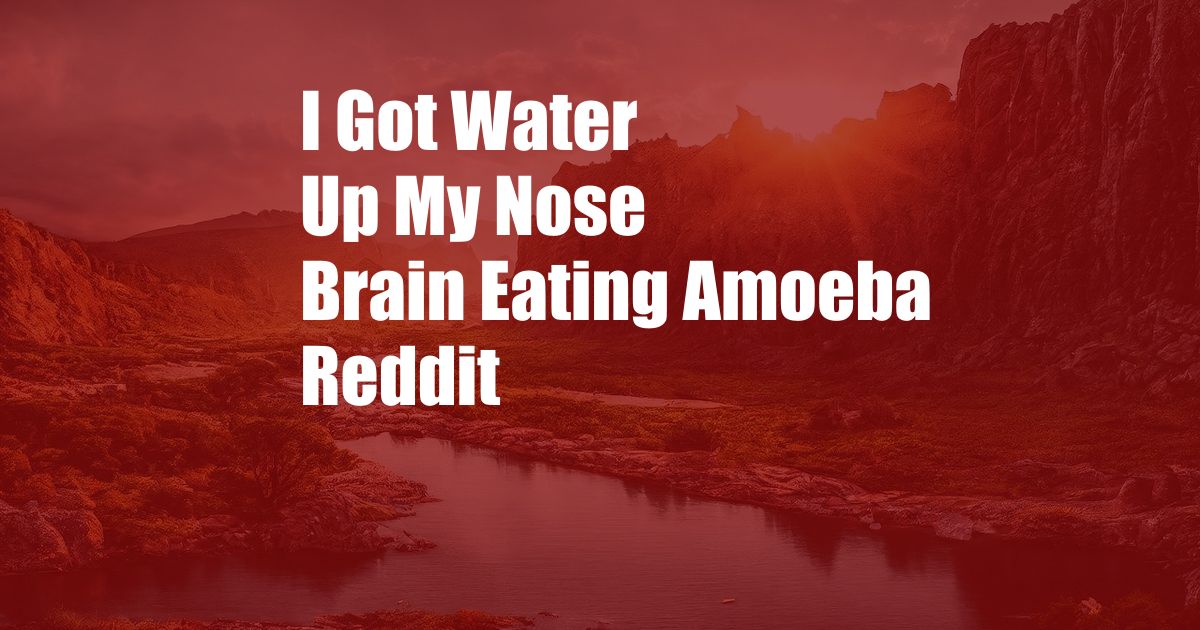
Water Up the Nose: Navigating the Risks and Realities
Personal Anecdote:
As a child, I recall diving into a refreshing lake on a scorching summer afternoon. The crystal-clear water enticed me, and I dove headfirst, only to feel a sudden, piercing sensation in my sinuses. Water had inundated my nasal cavity, leaving me coughing and fearing for the worst.
Nasal Irrigation: A Path to Relief
When water flows up your nose, it can lead to an unpleasant experience. This phenomenon, known as nasal irrigation, is the intentional introduction of water or saline solution into the nasal passages. While nasal irrigation can be beneficial for clearing nasal congestion, excessive or improper techniques can have adverse effects.
The Brain-Eating Amoeba: A Rare but Frightening Threat
One of the most serious potential risks associated with water up the nose is infection by a microscopic organism called Naegleria fowleri. Commonly referred to as the brain-eating amoeba, this parasite thrives in warm, still water bodies. If inhaled through the nose, it can travel to the brain, causing a rare but deadly infection known as primary amebic meningoencephalitis (PAM).
Understanding PAM and Its Symptoms
PAM is a devastating illness that can progress rapidly, often leading to death within days. Symptoms typically emerge within one to nine days of infection and may include:
- Severe headache
- Fever
- Nausea and vomiting
- Stiff neck
- Confusion
- Seizures
- Hallucinations
Prevention: Essential Steps to Stay Safe
Given the potential severity of PAM, it is crucial to take precautions while swimming in potentially contaminated water. Key preventive measures include:
- Avoid Swimming in Warm, Still Water: Naegleria fowleri thrives in warm, slow-moving water, such as that found in shallow lakes, ponds, and warm springs.
- Hold Your Nose Underwater: When diving or jumping into water, clamp your nose shut to prevent water from entering your nasal passages.
- Use Nasal Clips: For extended periods of exposure, consider using nasal clips to create a barrier.
Seeking Medical Attention: When to Be Concerned
If you experience any symptoms of PAM after swimming or nasal irrigation, seek medical attention immediately. Prompt diagnosis and treatment are essential for increasing the chances of survival.
Expert Advice for Navigating Nasal Irrigation
If nasal irrigation is necessary, follow these expert recommendations to minimize risks:
- Use Sterile Water or Saline: Prepare irrigation solutions with sterile or boiled water to prevent contamination.
- Avoid Over-Irrigation: Limit irrigation frequency to no more than once or twice per day to prevent inflammation.
- Gently Instill Solution: Angle the irrigation device towards the floor to gently deliver the solution into the nostrils.
- Blow Nose Gently: After irrigation, blow your nose gently to remove excess solution without forcing it back into the sinuses.
Common Questions on Water Up the Nose and PAM
-
Q: Can I get the brain-eating amoeba from swimming in chlorinated pools?
- A: No, Naegleria fowleri cannot survive in chlorinated water.
-
Q: What is the treatment for PAM?
- A: PAM treatment involves aggressive medical intervention, including antifungal medications and supportive care.
-
Q: How common is PAM?
- A: PAM is a rare but serious infection, with only a few cases reported each year in the United States.
Conclusion
Water up the nose can be an innocuous occurrence or a serious health concern, depending on the circumstances. Understanding the risks and taking necessary precautions can minimize the likelihood of infection. Remember, nasal irrigation should be performed safely, and any symptoms of PAM require immediate medical attention.